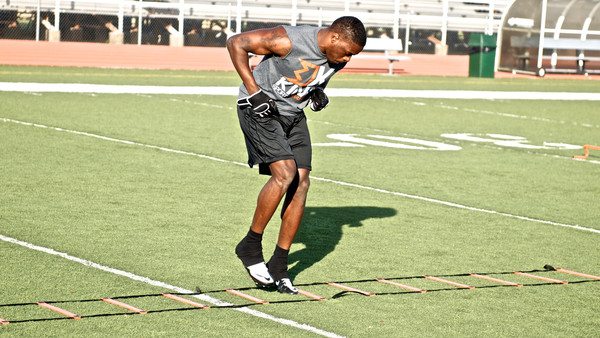Why speed/agility ladders don’t optimally improve speed or agility
[two_col_66_33_col1]
Poor Training Methodology: Agility Ladders
One of the most popular training gimmicks in strength and conditioning are agility ladders, also sometimes referred to as speed ladders. For clarity, agility can be defined as the ability to rapidly change directions, while speed simply refers to the ability for an athlete to travel at maximal velocities. Speed and agility are extremely important for success in team sports, and therefore care should be taken when attempting to develop each quality.
Speed and agility are closely related insofar as they are both affected by the athlete’s ability to apply force. Top speed is determined by the ability to apply force to the ground in a manner that maximizes stride length and frequency, whereas agility is determined by the ability to apply force in order to decelerate the body, redirect momentum, and re-accelerate explosively at a different angle. When high ground reaction forces are effectively applied, rate of force development increases and ground contact times decrease. In layman’s terms, this means that the athlete is applying more force to the ground in a shorter amount of time, which is the key to being explosive.
What factors affect speed/agility?
Speed and agility are affected by a number of interrelated physical characteristics, none of which are more important than lower body strength. Concentric lower body strength acts as a motor that allows athletes to powerfully extend the hips and legs in order to apply force to the ground and accelerate quickly to high velocity. Conversely, eccentric lower body strength acts as a braking mechanism that decelerates the body in order to control and redirect momentum in sharp changes of direction. In support, a study by Chaouachi et al. (2009) showed that 1RM squat performance was the best predictor of 5-10 metre sprint ability, while a study by Spiteri et al. (2014) showed that eccentric strength in particular correlated significantly with COD ability. Other important factors that contribute to speed and agility include inter- and intramuscular coordination, the elastic properties of muscles and tendons, reaction time, flexibility, balance and body composition, all of which can be improved by utilizing proper strength and conditioning methods.
Why are agility ladders poor?
A video of a fancy footwork drill from Cleveland Brown’s WR Andrew Hawkins recentlywent viral on social media. Ladder drills may look cool on YouTube, and may be fun to perform, but young athletes should know that these drills have extremely little transferto actual sport performance. The issue with agility ladders is that very little acceleration, deceleration, and change of direction occurs. Rather, athletes repetitively perform predetermined footwork patterns at a constant speed in the same direction and plane of movement. Moreover, ladder drills often cause athletes to tighten up their muscles, which is the last thing you want to do when attempting to run or move fast. Lastly, athletes often perform ladder drills with the head and eyes down, which is generally not how you want athletes to move tactically on the playing field.
How do you improve speed/agility?
To improve speed and agility, athletes would be better off performing exercises such as Olympic lift variations (e.g. power cleans, hang snatches, and high pulls) as well as squat and deadlift variations at heavy loads (85+% 1RM), which would develop hip and leg musculature and increase an athlete’s ability to apply force to the ground. Furthermore, athletes won’t get faster if they don’t practice running at high velocities. High velocity running is a skill, and therefore sprinting drills should be incorporated to refine technique, while accelerations from different start positions to varying distances should be use to practice joint angles for optimal speed development. Finally, plyometric drills such as box jumps, depth jumps, and hurdle hops should be incorporated in aprogressive and safe manner in order to increase joint stiffness, which allows the athlete to bounce off the ground with more elasticity through each step. This, coupled with appropriate sport practice should be adequate enough to increase performance in speed/agility tasks.
Conclusion
Overall, ladder drills are a poor tool for optimal speed and agility development. While novice athletes may experience a training effect from their use, it is important to note that ANY training stimulus will produce results in untrained athletes. Therefore, if an athlete reports feeling faster or more agile after using a ladder, they were likely poorly trained to begin with. While ladder drills may look cool and fun for athletes to perform, we should be striving to use methods that contribute to the optimal development of high performance athletes, rather than mediocre development of average athletes.
If ladder drills actually transferred to sport performance, wide receiver patterns might look more like this instead of what we actually see occur in the NFL. This parody clip also went viral on social media, but for the right reasons; reputable strength and conditioning coaches were laughing at and frowning upon poor training practices that do not benefit athletes.
Don’t be the next viral joke of the internet, and stop using agility ladders for speed, agility, and explosiveness.
[/two_col_66_33_col1]
[two_col_66_33_col2]
[/two_col_66_33_col2]



Leave a Reply
Want to join the discussion?Feel free to contribute!